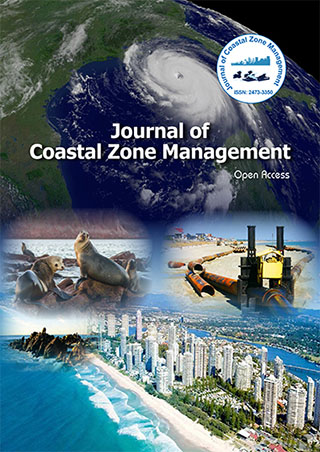Indexed In
- SafetyLit
- RefSeek
- Hamdard University
- EBSCO A-Z
- OCLC- WorldCat
- Publons
Useful Links
Share This Page
Journal Flyer

Open Access Journals
- Agri and Aquaculture
- Biochemistry
- Bioinformatics & Systems Biology
- Business & Management
- Chemistry
- Clinical Sciences
- Engineering
- Food & Nutrition
- General Science
- Genetics & Molecular Biology
- Immunology & Microbiology
- Medical Sciences
- Neuroscience & Psychology
- Nursing & Health Care
- Pharmaceutical Sciences
Opinion Article - (2024) Volume 27, Issue 5
Impacts of Coastal Mining on Fisheries and Livelihoods: A Regional Analysis
Sophy Dubois*Received: 28-Aug-2024, Manuscript No. JCZM-24-26826; Editor assigned: 30-Aug-2024, Pre QC No. JCZM-24-26826 (PQ); Reviewed: 13-Sep-2024, QC No. JCZM-24-26826; Revised: 20-Sep-2024, Manuscript No. JCZM-24-26826 (R); Published: 27-Sep-2024, DOI: 10.35248/2473-3350.24.27.644
Description
Coastal mining, which involves the extraction of minerals and resources from coastal and marine environments, has significant economic benefits but also poses risks to marine ecosystems and local communities. This is particularly evident in regions where fisheries lead a significant role in the livelihoods of coastal populations. Analyzing the impacts of coastal mining on fisheries and local livelihoods reveals both the direct and indirect effects of these activities, highlighting the need for balanced approaches to resource management.
Impacts on fisheries
Coastal mining activities involve dredging, sand mining and the removal of sediment, which can lead to the destruction of critical marine habitats such as coral reefs, seagrass beds and mangroves. These habitats are essential for the life cycles of many fish species, including those that are commercially important. The loss or degradation of these habitats disrupts breeding grounds, nurseries and feeding areas, leading to declines in fish populations.
The alteration of coastal environments due to mining can lead to shifts in marine ecosystems. Changes in sediment composition, water flow and nutrient levels can disrupt the balance of these ecosystems, leading to the proliferation of harmful algal blooms or invasive species. These changes can further impact fish populations and reduce the overall biodiversity of the marine environment.
Impacts on livelihoods
For many coastal communities, fisheries are a primary source of income and food security. The decline in fish stocks resulting from habitat destruction and water quality degradation directly impacts local fishers' income and livelihoods. Reduced fish catches mean lower earnings and economic instability for those reliant on fishing. This can also lead to increased competition for remaining resources and significant conflicts within the community.
Fishing is deeply involved in the cultural and social fabric of coastal communities. The decline in fish populations and the disruption of traditional fishing practices can erode cultural traditions and social cohesion. Communities may experience a loss of traditional knowledge and practices related to fishing and marine resource management.
The contamination of fish and seafood by pollutants from mining activities can have serious health implications for local populations. Consuming contaminated fish can lead to health issues such as food poisoning or chronic diseases. Additionally, the loss of fish as a primary food source can affect nutritional health, particularly in communities that rely heavily on fish for their diet.
Regional analysis
Regional variations in the impacts of coastal mining on fisheries and livelihoods can be significant, depending on local ecological conditions, the scale of mining activities and the dependence of communities on fishing. For instance:
In regions like the Mekong Delta, extensive sand mining has led to habitat destruction and water quality issues, significantly affecting local fisheries and the livelihoods of millions who depend on them.
In coastal areas of Kenya and Tanzania, heavy mineral mining has impacted mangroves and coral reefs, significant for the local fishing industry. This has resulted in reduced fish catches and economic hardship for coastal communities.
In northern Australia, heavy mineral mining operations have affected coral reef ecosystems, leading to declines in fish populations and posing challenges for local fishers who rely on these reefs for their livelihoods.
The impacts of coastal mining on fisheries and local livelihoods are profound and multifaceted. Habitat destruction, water quality degradation and changes in marine ecosystems pose significant risks to fish populations, which directly affect the economic stability, cultural practices and health of coastal communities. Regional analyses highlight the varying impacts based on local conditions and the scale of mining activities. Addressing these impacts requires integrated management approaches that balance economic development with the protection of marine environments and the well-being of local communities. Sustainable mining practices, coupled with effective environmental regulations and community engagement, are essential to mitigating the adverse effects of coastal mining and supporting the resilience of fisheries and livelihoods.
Citation: Dubois S (2024). Impacts of Coastal Mining on Fisheries and Livelihoods: A Regional Analysis. J Coast Zone Manag. 27:644.
Copyright: © 2024 Dubois S. This is an open-access article distributed under the terms of the Creative Commons Attribution License, which permits unrestricted use, distribution, and reproduction in any medium, provided the original author and source are credited.
